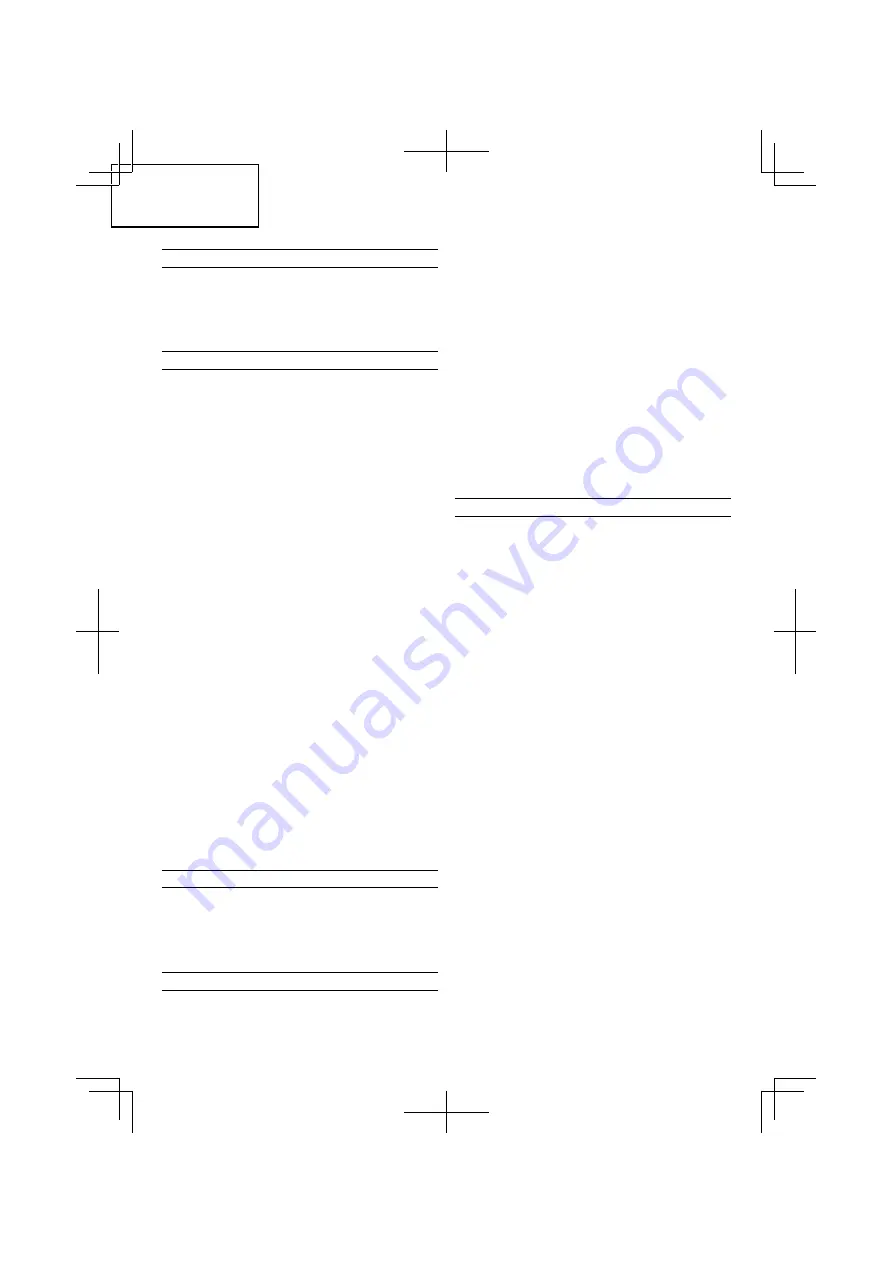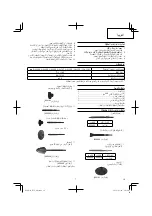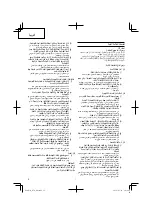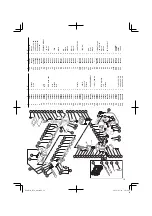
5
English
APPLICATIONS
Crushing concrete, chipping, digging, and squaring.
Application examples:
Installation of piping and wiring, sanitary facility installation,
machinery installation, water supply and drainage work,
interior jobs, harbor facilities and other civil engineering
works.
PRIOR TO OPERATION
1. Power source
Ensure that the power source to be utilized conforms
to the power requirements speci
fi
ed on the product
nameplate.
2. Grounding
This tool should be grounded while in use to protect the
operator from electric shock. The tool is equipped with a
three conductor cord and grounding type plug to
fi
t the
proper grounding type receptacle. The green (or green
and yellow) conductor in the cord is the grounding wire.
Never connect the green (or green and yellow) wire to a
live terminal.
3. Power switch
Ensure that the power switch is in the OFF position. If the
plug is connected to a receptacle while the power switch
is in the ON position, the power tool will start operating
immediately, which could cause a serious accident.
4. Extension cord
When the work area is removed from the power source,
use an extension cord of su
ffi
cient thickness and rated
capacity. The extension cord should be kept as short as
practicable.
5. Feeding oil (refer to the paragraph on oil feeding)
Prior to using the power tool, remove the oil gauge and
do not fail the oil tank with the provided oil. (Although the
oil tank is built in, it contains only a small volume of oil
when shipped from the HiKOKI Works.)
6. Mounting a tool
NOTE
When handling bull point, cold chisel and other
accessories, HiKOKI standard tools are recommended
for better operation.
(1) Turn the stop lever in the arrow direction, insert the tool
shank into the hexagon hole on the front cover.
(2) Replace the stop lever to grip the tool
fi
rmly.
NOTE
When removing the tool, follow the above procedures in
reverse.
7. Set the side handle
When the M8 bolt is loosened with hexagon bar wrench,
the side handle becomes freely movable. Set the side
handle to a position conforming to the job, and then
securely clamp the bolt.
HOW TO USE THE DEMOLITION HAMMER (Fig. 3)
1. Pull the trigger switch after applying the tip of the bit to the
crushing position.
2. Operate the tool by utilizing its empty weight. The
performance will not be better even if the tool is pressed
or thrust forcibly against the work surface. Hold the tool
with a force just su
ffi
cient to counteract the reaction.
OIL FEEDING
CAUTION
Prior to oil feeding, always disconnect the plug from the
receptacle.
Since an oil chamber is built in this Demolition Hammer, it
can be used for approximately 20 days without replenishing
lubricating oil, assuming that the Hammer is used
continuously 3 – 4 hours daily.
Feed oil into the oil tank as described below before using this
Hammer. (see
Fig. 4
and
5
)
1. Just before no oil is visible in the oil gauge window when
the power tool is held upright, feed oil without fail.
2. Before feeding oil, use the provided wrench to remove
the oil gauge.
Be careful not to lose the rubber packing attached below
the oil gauge.
3. Check the oil level once a day, con
fi
rming that oil is
fi
lled.
4. After feeding oil, securely clamp the oil gauge.
NOTE
As an optional accessory, oil for the HiKOKI Demolition
Hammer (one liter) is sold separately. Use this oil when
oil in the tank is depleted. Shell Oil Co. ROTELLA #40
(engine oil) can also be used. This oil is sold as Shell
gasoline stations most anywhere.
MAINTENANCE AND INSPECTION
CAUTION
Be sure to swith OFF and disconnect the attachment plug
from the receptacle to avoid a serious accident.
1. Inspecting the tool
Since use of a dull tool will cause motor malfunctioning
and degraded e
ffi
ciently, whet it or replace with a new
one without delay when abrasion is noted.
2. Inspecting the mounting screws
Regularly inspect all mounting screws and ensure that
they are properly tightened. Should any of the screws be
loose, retighten them immediately. Failure to do so could
result in serious hazard.
3. Maintenance of the motor
The motor unit winding is the very “heart” of the power
tool. Exercise due care to ensure the winding does not
become damaged and/or wet with oil or water.
4. Inspecting the carbon brushes (Fig. 6)
The Motor employs carbon brushes which are
consumable parts. When they become worn to or near
the “wear limit”, it could result in motor trouble. When an
auto-stop carbon brush is equipped, the motor will stop
automatically. At that time, replace both carbon brushes
with new ones which have the same carbon brush
numbers shown in the
fi
gure. In addition, always keep
carbon brushes clean and ensure that they slide freely
within the brush holders.
5. Replacing carbon brushes
The carbon brushes can be removed by removing the tail
cover, and brush caps in that order at the interior.
6. Service parts list
A: Item No.
B: Code No.
C: No. Used
D:
Remarks
CAUTION
Repair,
modi
fi
cation and inspection of HiKOKI Power
Tools must be carried out by a HiKOKI Authorized
Service Center.
This Parts List will be helpful if presented with the tool to
the HiKOKI Authorized Service Center when requesting
repair or other maintenance.
In the operation and maintenance of power tools, the
safety regulations and standards prescribed in each
country must be observed.
000Book̲H50̲Asia.indb 5
000Book̲H50̲Asia.indb 5
2018/03/22 14:30:40
2018/03/22 14:30:40






































